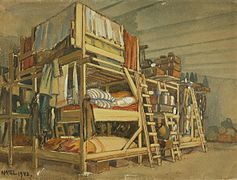František Mořic Nágl
František Mořic Nágl (born May 28, 1889 in Kostelní Myslová , Austria-Hungary ; † October 28, 1944 in Auschwitz ) was a Czech painter .
Life until 1939
Nágl was born as one of three children to a Jewish family in Kostelní Myslová, a village near the small town of Telč (now the Czech Republic ). The family owned a farm that he should later have taken over management. Due to his artistic talent, however, after finishing high school in Telč, he switched to the arts and crafts school in Prague , which he attended from 1905 to 1908. He then studied until 1912 at the Prague Academy of Fine Arts in the special class of Hanuš Schwaiger . After completing his studies in Prague, Nágl returned to his home village and devoted himself primarily to painting on the family estate. Just one year later he was able to take part in an art exhibition in Prague's Rudolphinum .
During the First World War , Nágl, who had been drafted into the infantry , suffered a serious injury to his arm. The treating surgeon in Vienna managed to preserve his arm so that Nágl could continue his work as a painter after a long rehabilitation. He joined an artists' association in Hodonín and took part in their exhibitions. Nágl found the motifs for his painting in his immediate surroundings: this is how watercolors of Moravian landscapes, city images and genre paintings from village life were created. In 1919 he exhibited a series of watercolors with Brno motifs in Brno .
In 1920 František Mořic Nágl married the violinist Vlasta Nettelová, their daughter Věra was born in 1921 and their son Miloslav was born the following year. The young family initially stayed in Kostelní Myslová. When the children reached high school, they moved to a house in Telč, while Nágl kept his studio in Kostelní Myslová. In 1933 he was able to show his watercolor "Market on Dominican Square in Brno" in Prague, and in 1937 a retrospective of the increasingly famous painter was presented in Ostrava .
Deportation and death
After the smashing of Czechoslovakia and the proclamation of the Protectorate of Bohemia and Moravia on March 16, 1939, the National Socialists confiscated the property of the Jewish Nágl family and prevented the children from further schooling. On May 22, 1942 the family was deported to the Theresienstadt ghetto . Nágl managed to bring some painting utensils into the camp and - supported by the council of elders of the Jewish self-government - set up a provisional studio in a small room on the floor of one of the houses. Here 254 watercolors and gouaches were created with motifs from camp life.
On September 6, 1943, Nágl's son Miloslav was transported to the Auschwitz concentration camp and murdered there. On October 28, 1944, František Mořic Nágl, his wife Vlasta and his daughter Věra were also deported to Auschwitz on the last transport from Theresienstadt and gassed there .
In 1950, construction workers accidentally found Nágl's pictures from Theresienstadt - he had walled them up in his studio in the attic and thus preserved them for posterity.
Work examples
For some of the works shown here, the year of creation is unknown.
Individual evidence
(Sources see literature and web links)
literature
- Vojtěch Blodig: culture against death . Permanent exhibitions of the Theresienstadt Memorial in the former Magdeburg barracks. 1st edition. Helena Osvaldová, Prague 2002, ISBN 80-85433-84-2 , p. 136 .
- Oldřich Klobas: Malíř neumírá . Dobrý důvod, Telč 2004, ISBN 80-903546-0-2 , p. 73–75 (Czech, summary in English and German).
Web links
- Terezie Veselá: František Mořic Nágl. City of Telč, accessed on June 12, 2016 .
- Biography at exil-archiv (accessed 2016-06-12)
- Biography on ghetto-theresienstadt.info (accessed 2016-06-12)
- Biography (Czech, with photo) in the portal holocaust.cz (accessed 2016-06-12)
| personal data | |
|---|---|
| SURNAME | Nágl, František Mořic |
| BRIEF DESCRIPTION | Czech painter, victim of the Holocaust |
| DATE OF BIRTH | May 28, 1889 |
| PLACE OF BIRTH | Kostelní Myslová, Austria-Hungary |
| DATE OF DEATH | October 28, 1944 |
| Place of death | Auschwitz concentration camp , Poland |






